by Brian Hioe
語言:
English
Photo Credit: Brian Hioe
The Anti-Textbook Revision Campaign
IT IS HARD to point to an exact date in which the series of events that culminated in last month’s occupation of the Ministry of Education began. Are we go back to last years Sunflower Movement? The Anti-Textbook Revision campaign which began several months ago? Or July 23rd?
But it may be most appropriate to date the Ministry of Education occupation of the past month to July 23rd. While protests concerning the planned textbook revisions which would instill a Sinocentric view of history have been ongoing for months, a large protest took place on July 5th. Though not a major protest, the demonstration drew out a little over a thousand and culminated in an action which involved throwing paper airplanes into the Ministry of Education courtyard. Who would have thought that just a month later, students would have found themselves storming and occupying the Ministry of Education courtyard?
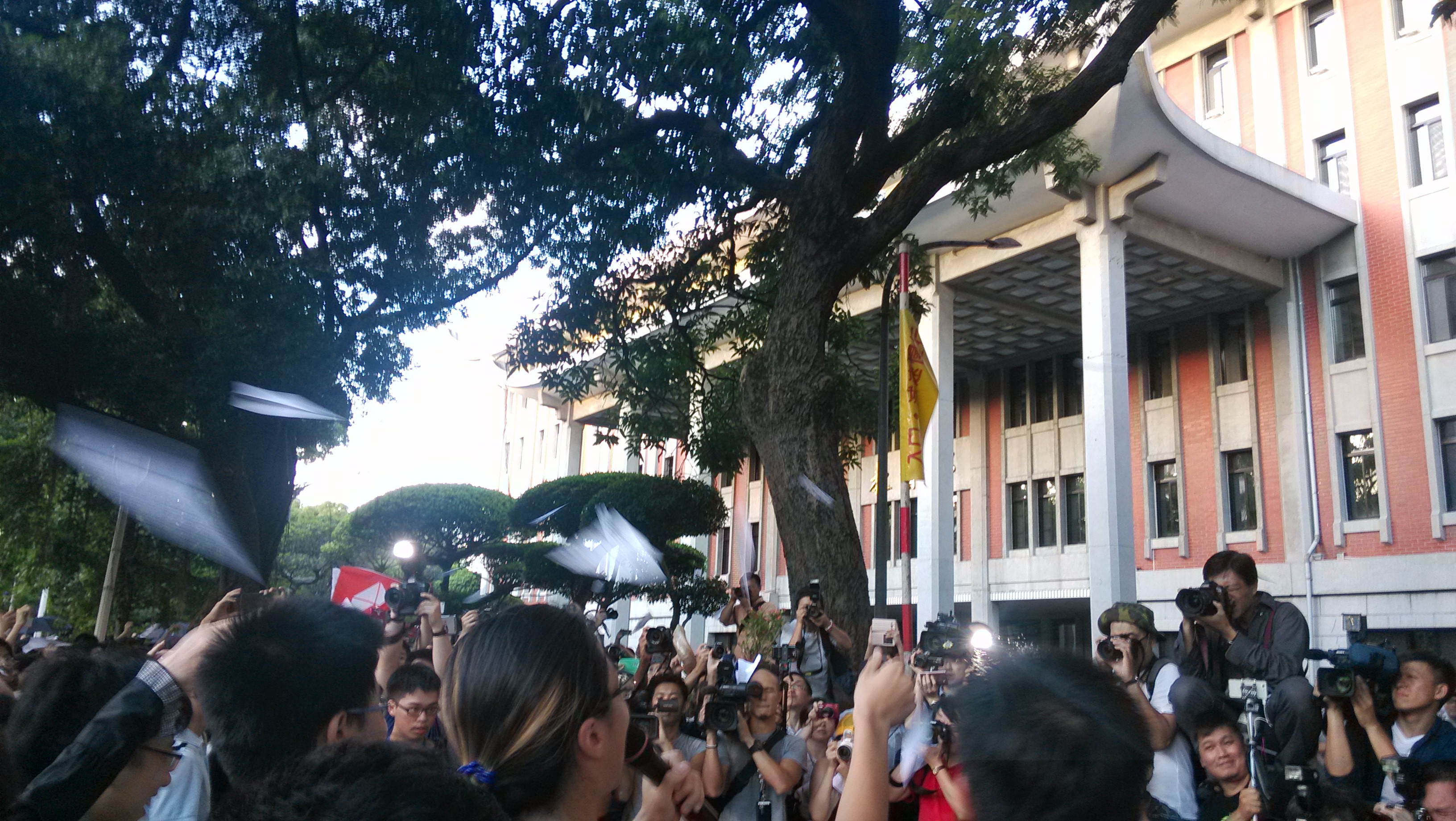 Paper airplanes being thrown into the Ministry of Education courtyard on July 5th. Though not as successful an action compared to later ones, the paper airplane nevertheless later became a symbol of the Ministry of Education occupation. Photo credit: Brian Hioe
Paper airplanes being thrown into the Ministry of Education courtyard on July 5th. Though not as successful an action compared to later ones, the paper airplane nevertheless later became a symbol of the Ministry of Education occupation. Photo credit: Brian Hioe
The occupation was most directly the product of the actions which took place on the night of July 23rd. Namely, there had been a campaign to encircle the Ministry of Education which had began with a protest that took place on July 22nd. This had been talked about for several months beforehand, as a “Second Sunflower Movement.” But there was little indication at that time that anything large-scale would emerge at that point in time. Actually, although it surprised even me at the time, the protest which took place on July 22nd was not as large as the protest which took place on July 5th.
The night of July 23rd, however, saw an attempt to occupy the Ministry of Education. This was unsuccessful, despite that a crowd of two hundred gathered at that point in time. However, a group of students made it as far as the office of the Minister of Education and were able, for a time, to briefly occupy it before later arrest. Thirty-three were arrested then, including 24 students, six members of the public, and 3 journalists.
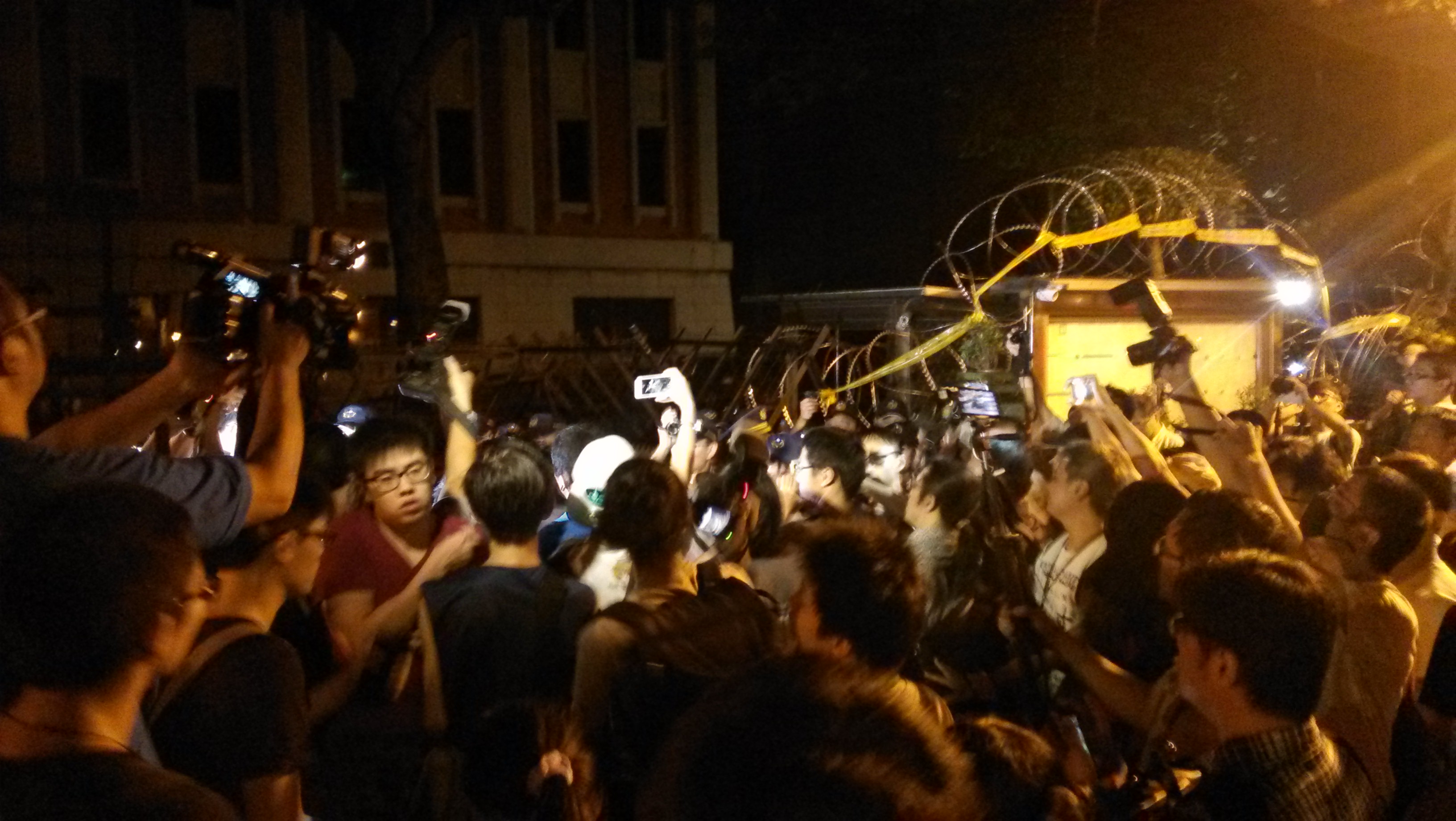 Protestors pushing up against barriers of the Ministry of Education on the night of July 23rd. Photo credit: Brian Hioe
Protestors pushing up against barriers of the Ministry of Education on the night of July 23rd. Photo credit: Brian Hioe
However, where the circumstances of the Ministry of Education occupation which took place later in August were a product of the events that took place on July 23rd, it is because of the attempt to occupy the office of the Minister of Education that took place on that night. Namely, protests were set off by the suicide of Lin Kuanhua, also known as Dai Lin, which took place on July 30th. But a contributing factor was that Lin Kuanhua was the first of those who attempted to occupy the Minister of Education’s office which took place on July 23rd.
The Ministry of Education Occupation From Beginning to End
LIN KUANHUA’S suicide took place on the morning of July 30th. And it would be from the explosion which followed from outrage over his suicide which led to the occupation of the Ministry of Education courtyard. It would be this which led to the spontaneous occupation of the Ministry of Education which took place later that night.
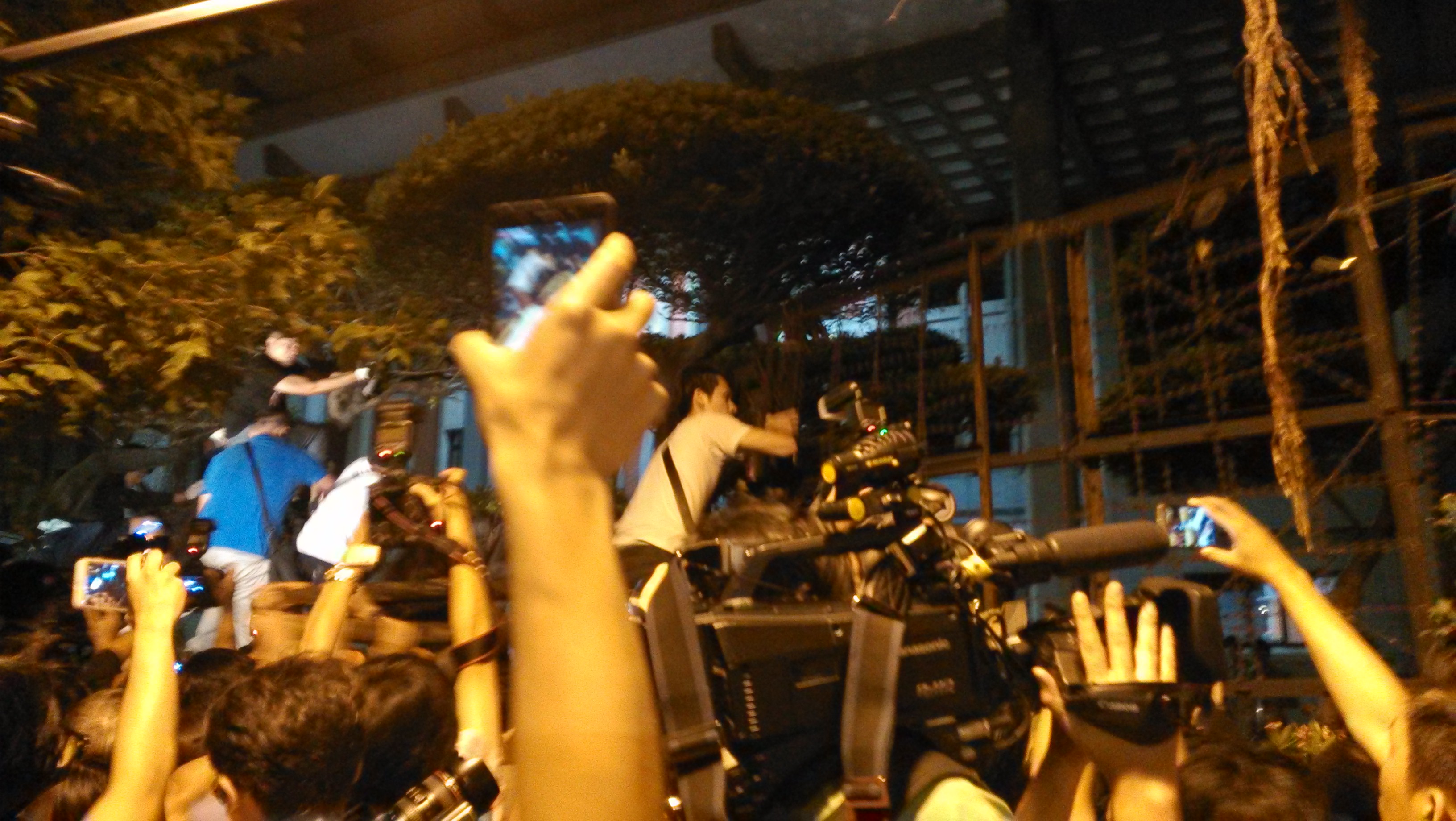 What was initially a mourning ceremony for Lin Kuanhua eventually transformed into storming the courtyard of the Ministry of Education on the night of July 30th. Photo credit: Brian Hioe
What was initially a mourning ceremony for Lin Kuanhua eventually transformed into storming the courtyard of the Ministry of Education on the night of July 30th. Photo credit: Brian Hioe
Although a crowd of over a thousand would gather the night, the occupation of the Ministry of Education first began with a crowd of several hundred overrunning the front gate of the Legislative Yuan and several individuals actually getting inside the Legislative Yuan before the crowd moved to the Ministry of Education. The crowd would then force down the eight or nine foot tall razor wire barriers. Even if never able to get into the Ministry of Education itself, the crowd would then occupy the courtyard of the Ministry of Education.
Though the night after the occupation on July 31st happened drew a large crowd, seemingly consisting largely of curious individuals, the threat police eviction when numbers were low was a pressing worry throughout the course of the occupation. By then, the occupation encampment which would last throughout the week had already spread up.
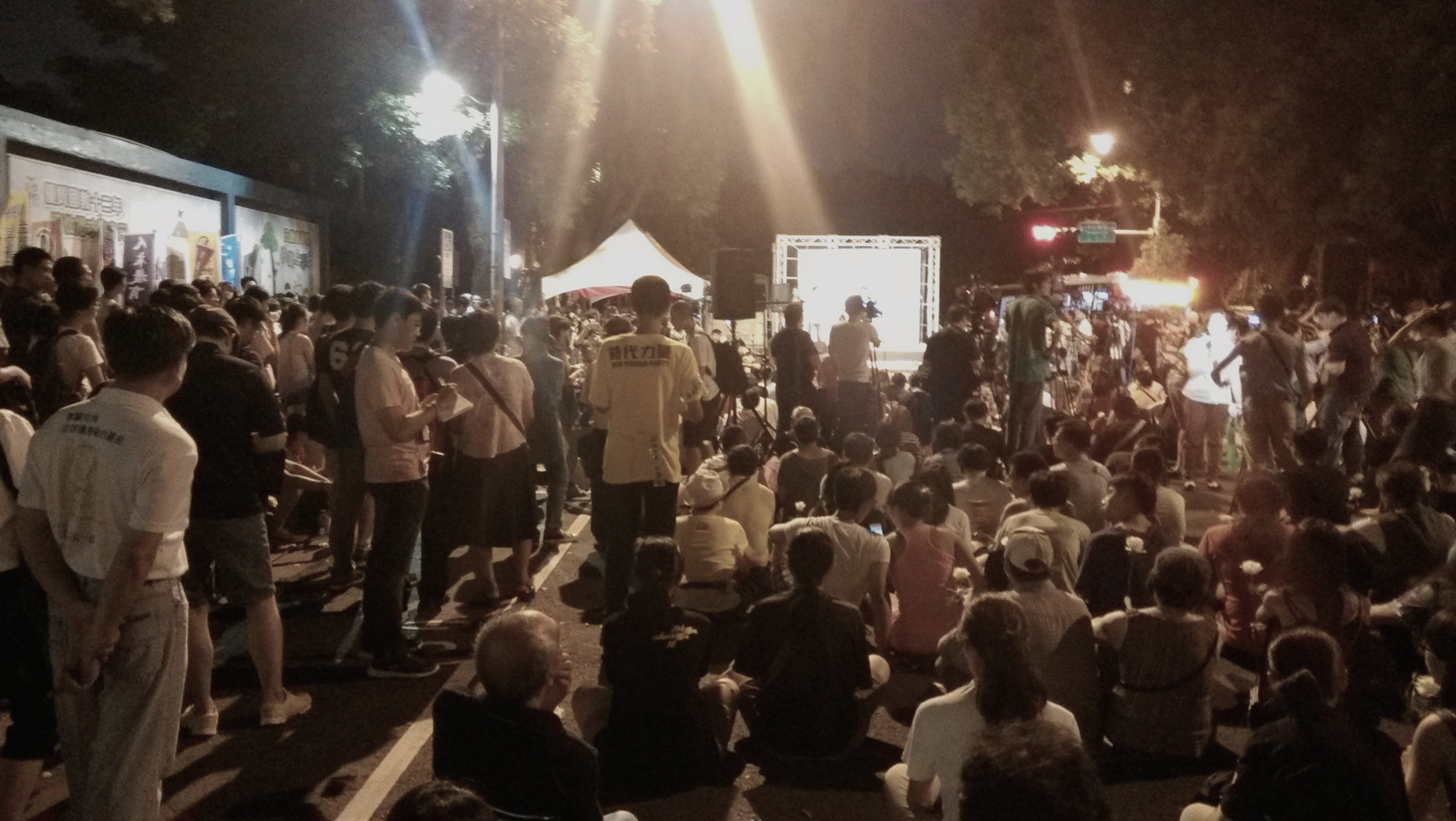 As with last year’s Sunflower Movement, speeches and rallies were held on Jinan Road. Photo credit: Brian Hioe
As with last year’s Sunflower Movement, speeches and rallies were held on Jinan Road. Photo credit: Brian Hioe
The occupation encampment highly recalled last year’s Sunflower Movement in modes of organization, however, was not as large. Given that this movement was a movement of high schoolers versus last year’s college students, the main organizers were much younger than before. As with before, activities held through the course of the occupation included musical performances, speeches, film screenings, and rallies. Taipei mayor Ko Wen-Je would visit as early as July 31st, stressing that he would do his best to restrain police if protestors kept themselves orderly, and suggesting sympathy. Ko had, of course, in the past been a vocal critic of the Ministry of Education and had largely been put in power by the forces of Taiwanese civil society which were active in both this occupation and last year’s Sunflower Movement.
Yet one was actually, in fact, somewhat put out at the low numbers for the first rally put on by the occupation on August 1st, held on Jinan Road. The rally which followed on the afternoon of August 2nd was large, involving probably around 2,000 people circling around on Zhongshan South Road, and this was followed by a concert at night which drew out such big names as speakers as Freddy Lim and well-known bands as Sorry Youth. Anxiety that an eviction would took place during August 2nd was particularly high, however, when it was discovered that a water cannon truck registered to central government and not Taipei was parked behind the Ministry of Education and had its water pumps hooked up for possible future use.
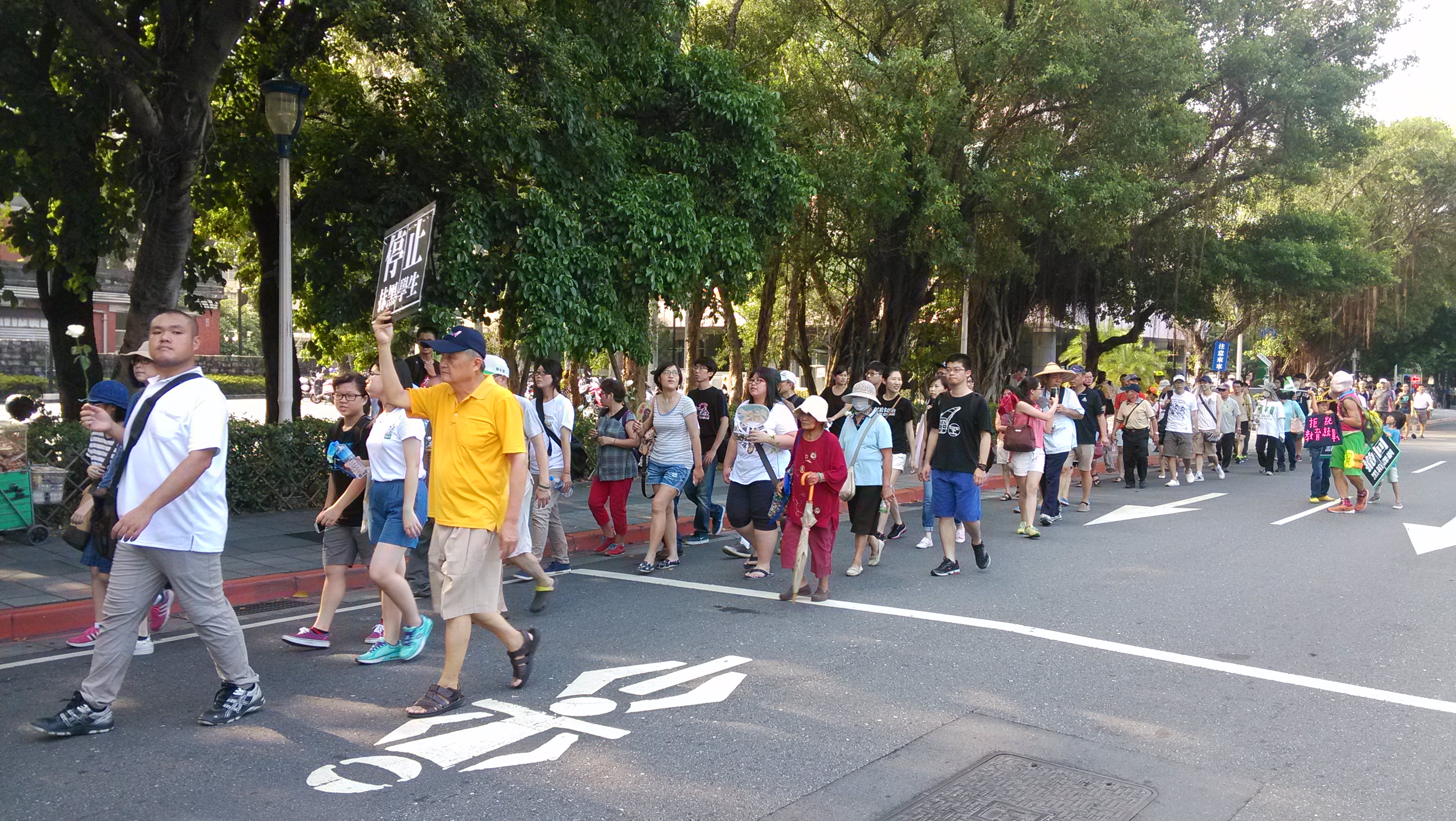 Demonstrators on the afternoon of August 2nd. Photo credit: Brian Hioe
Demonstrators on the afternoon of August 2nd. Photo credit: Brian Hioe
But if students had been quite clear on what their demands were from the beginning—the repeal of the planned textbook changes and the resignation of Minister of Education Wu Se-Hwa, who was blamed for the series of events which led to Lin Kuanhua’s suicide—attempts to negotiate with the government had been ongoing throughout. On the morning after the initial night of the occupation, it was demanded that a meeting be held with Wu Se-Hwa be held during when Wu would have normally come to work. Wu failed to materialize in the morning but later appeared in the afternoon, except dialogue broke down relatively quickly.
The initial occupation having happened on a Thursday night, the KMT later offered dialogue on Monday, perhaps hoping to conduct a dialogue after the weekend, at a time in which less people would have been on-site. This was rejected by students, who demanded a dialogue with Wu Se-Hwa himself and nobody lower in authority, and that dialogue with him would have to be open and public.
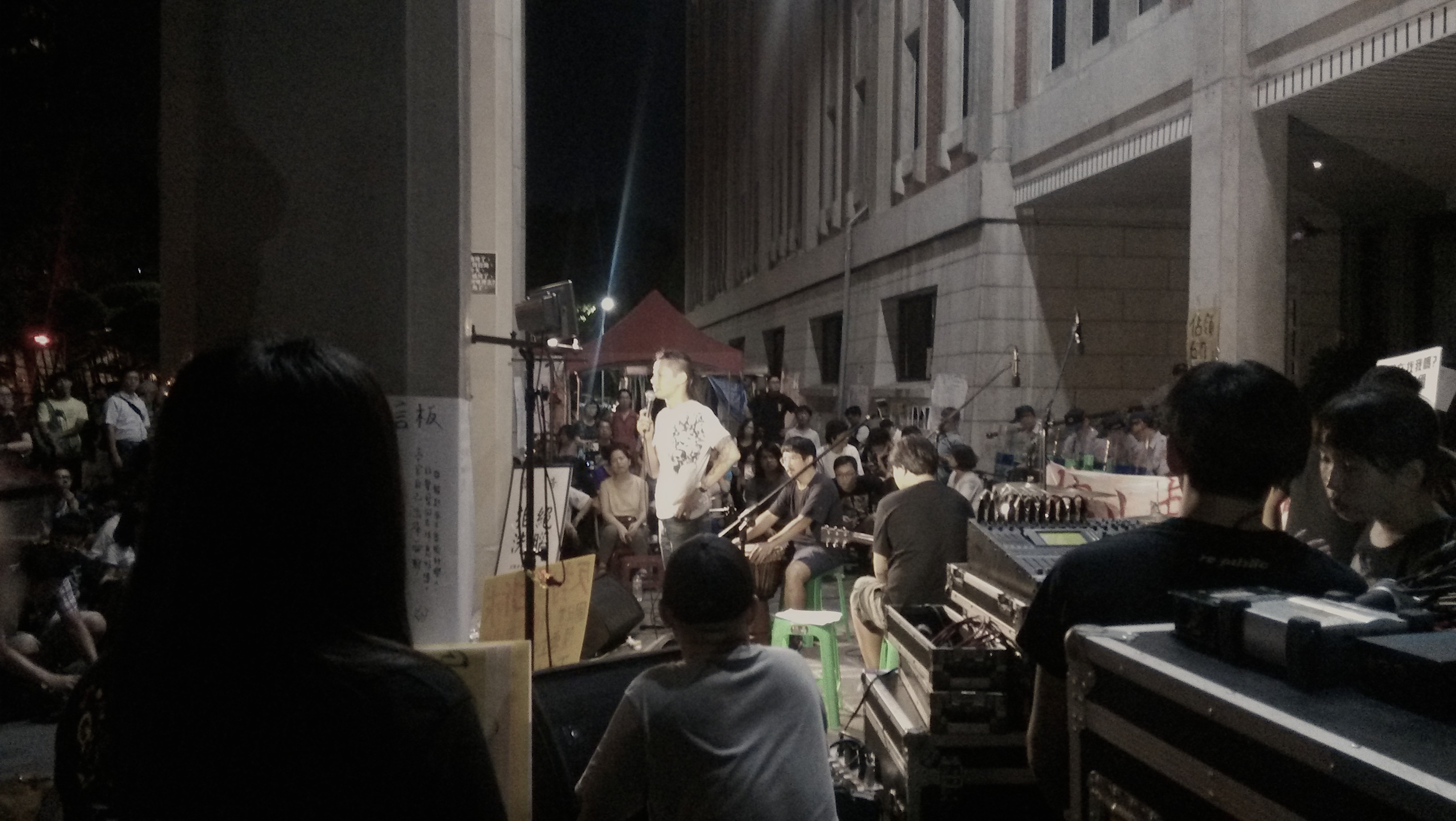 Freddy Lim of the New Power Party giving a speech at the concert held on the night of August 2nd, after the end of the demonstrations in the afternoon. Photo credit: Brian Hioe
Freddy Lim of the New Power Party giving a speech at the concert held on the night of August 2nd, after the end of the demonstrations in the afternoon. Photo credit: Brian Hioe
It was announced at the end of the concert on the night of August 2nd that the students would hold a dialogue with Wu Se-Hwa the next day at National Central Library. This was to be open to the media, as initially announced. But in the end, the meeting took place in a closed room in which only some members of the media were allowed to attend directly and broadcast on television, the rest of the meeting being livestreamed.
One of the highly public spectacles of the movement on August 3rd, then, was when students stormed out of the meeting one-by-one and later broke down in tears because of Wu’s unwillingness to negotiate or back down in any way at the meeting. Wu also became the object of a viral meme after caught on camera rolling his eyes in response to criticisms by a National Taiwan University professor. But the site of students in tears after the failed meeting was broadcast widely throughout media and served to garner much sympathy. However, at that point, in retrospect we can see that at that point in time the ultimate resolution of the movement was already turning towards allowing individual high schools decide which textbook to use.
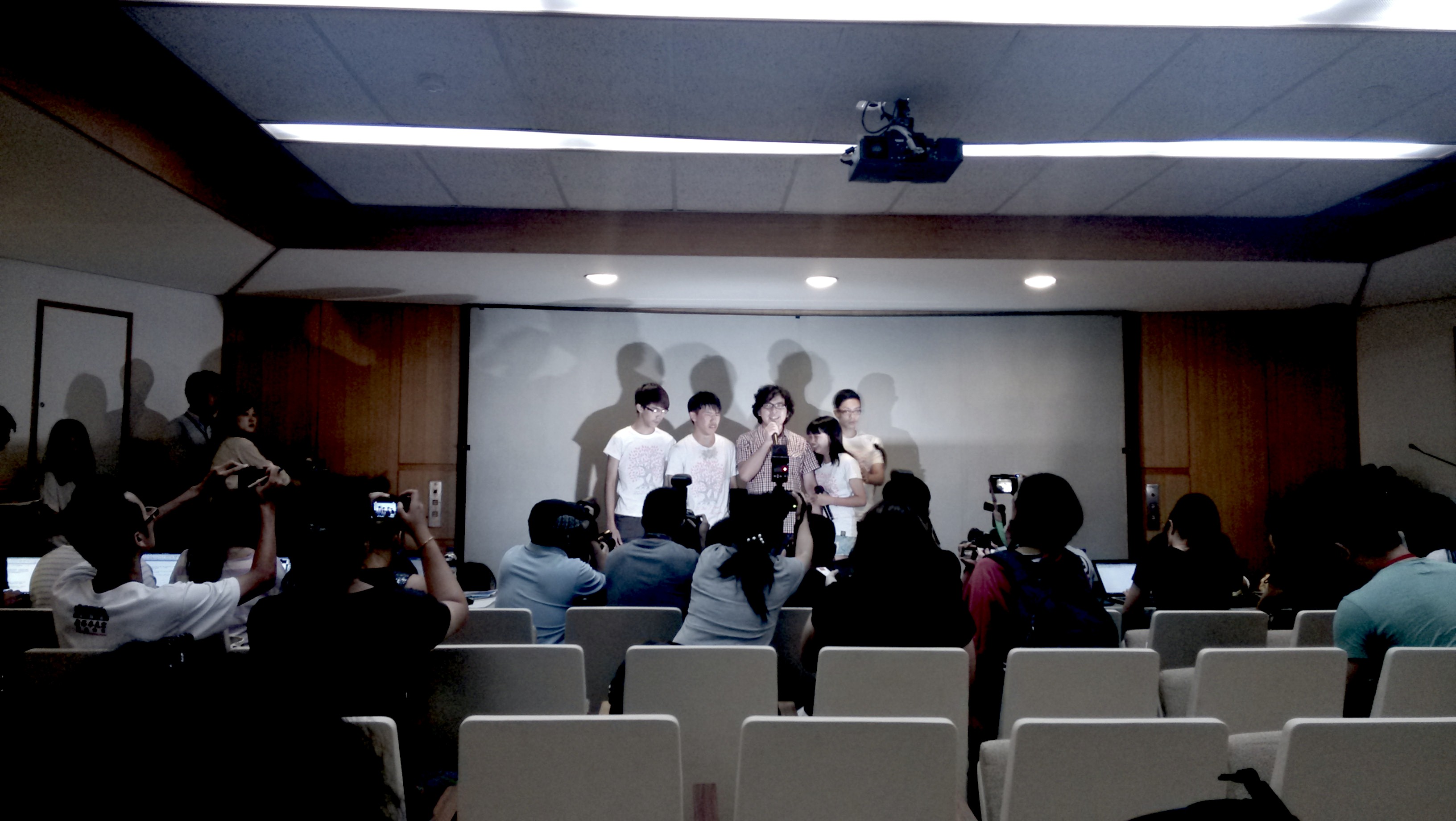 Students sobbing in front of media after the breakdown of discussions with Wu Se-Hwa at National Central Library. Photo credit: Brian Hioe
Students sobbing in front of media after the breakdown of discussions with Wu Se-Hwa at National Central Library. Photo credit: Brian Hioe
A “big bowel blossom discussion forum”, a type of discussion forum in which protestors would give vent to their frustration, was held that night, organized by well-known activist Indie DaDee. Many such forums had been held last year during the Sunflower Movement, “big bowel blossom” being a pun on the characters for “Sunflower Movement.” Students gave vent to their frustrations about their inability to resolve the impasse then. DPP presidential candidate Tsai Ing-Wen would also pay a covert visit to the occupation site that night after midnight, though she did not highly publicize the visit, but rather allowed news to spread on its own among activist networks.
Subsequently, August 4, however, saw further retrenchment on the part of the KMT. Students had demanded the holding of a special session of legislature to discuss the textbook issue, but the KMT would vote against this with near unanimity. Threats to the movement also seemed pressing, with a police raid conducted on the apartment of one of the student activists, Yang Shangen, despite the apparent illegality of the procedure. A typhoon was on the horizon, Typhoon Soudelor, which would be the strongest typhoon of 2015 to date. It would be difficult to maintain an occupation outside in such weather.
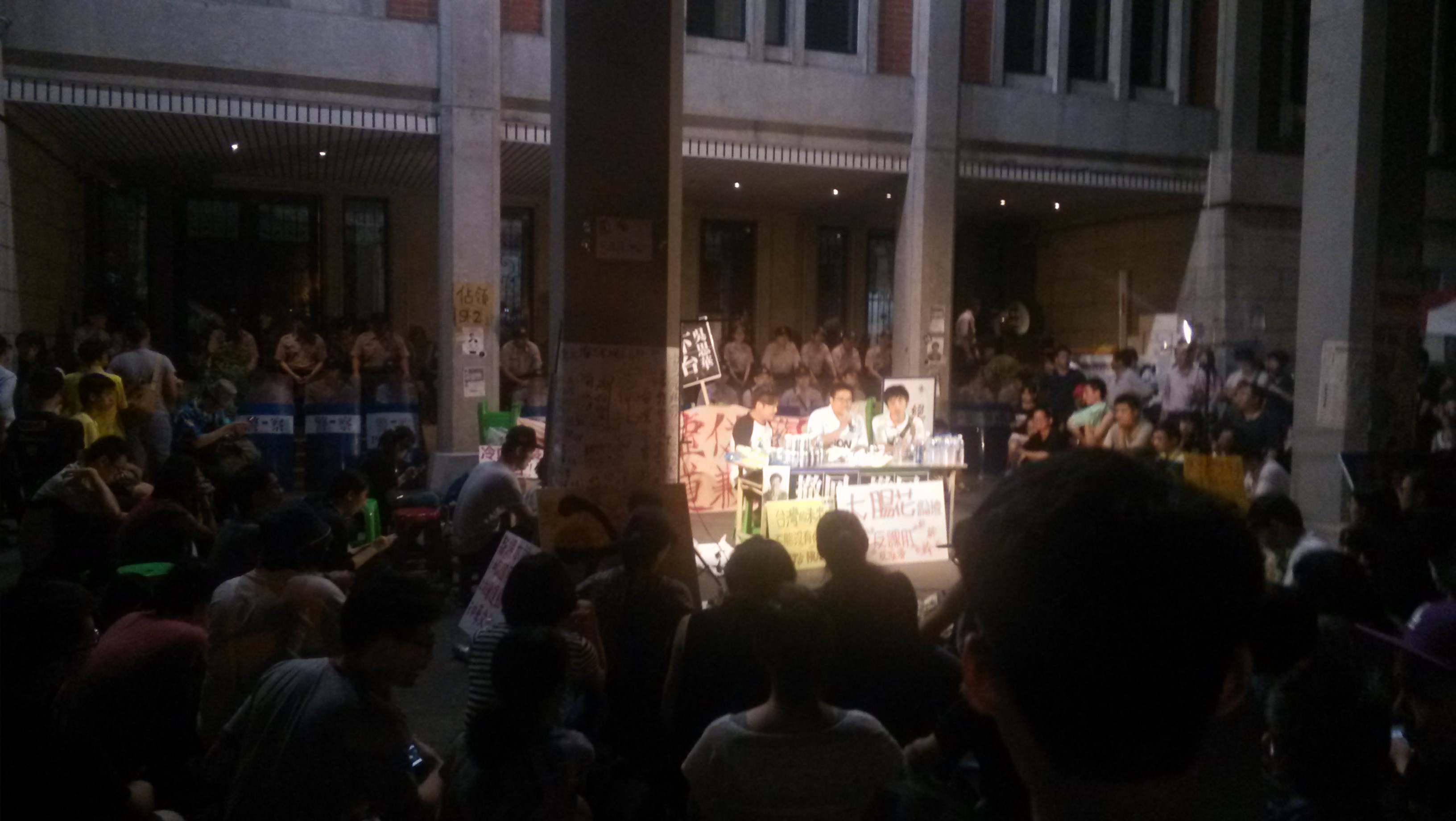 The “big bowel blossom discussion forum” held on the night of August 3rd after negotiations with Wu Se-Hwa had broken down that afternoon, Photo credit: Brian Hioe
The “big bowel blossom discussion forum” held on the night of August 3rd after negotiations with Wu Se-Hwa had broken down that afternoon, Photo credit: Brian Hioe
And infamous gangster turned pro-China politician White Wolf Chang An-Lo announced that he would be be paying a visit to the Ministry of Education encampment the next day at 7:30 PM. Chang had done something similar during last year’s Sunflower Movement, in which he arrived with 200 drugged up gangsters to intimidate the student occupiers. Chang, of course, in addition to having conducted political assassination for the KMT during the period of Martial Law, is also quite close with family members of current Taiwanese president Ma Ying-Jeou.
August 5th, then, was a day filled with bizarre spectacle. Given that Chang embraces a form of mainland Chinese-oriented, Han nationalism and criticizes Taiwanese youth for having become “too Japanese”, Chang and a cohort of 30 to 40 individuals showed up unexpectedly outside DPP headquarters dressed as Japanese imperial soldiers from the era of the Japanese empire. Chang and company mocked the DPP for being running dogs of the Japanese before leaving.
In the afternoon of August 5th, three of the seven student representatives who had met with Wu Se-Hwa on August 3rd announced that they were withdrawing from the decision-making body of the movement. They stated that they would not be withdrawing from the movement itself, but that they were tired, and could not continue. However, these three were largely not seen on the occupation site in coming days. This was one of the first highly visible signs that under duress, a rift was forming between those who wanted to stay and those who wanted to withdraw, where students had previously vowed not to leave the occupation encampment until textbooks were repealed—never mind if that meant enduring a typhoon.
 White Wolf Chang An-Lo giving a speech at his rally on August 5th. Photo credit: Brian Hioe
White Wolf Chang An-Lo giving a speech at his rally on August 5th. Photo credit: Brian Hioe
Such questions were put on hold when Chang did show up at 7:30 PM that night, as he had announced, with several hundred members of his pro-China forces. Though some had wondered whether Chang would truly come, given he had already made a surprise appearance at DPP headquarters, Chang showed up—this time in normal clothing. Chang and company played Chinese patriotic anthems, held up anti-Japanese placards, and gave speeches. Police, however, largely kept Chang’s group separated from the protestors across Zhongshan South Road. Present along with Chang was Zhang Xiuye of the Concentric Patriotism Alliance, another individual known for the use of violence.
And it would seem this was the high point of the occupation. Apart from that a large number of individuals appeared to defend the students in the hour before Chang’s announced arrival at 7:30 PM, the Taiwan Solidarity Union Youth Corps made a surprise mass appearance at 7:30 PM holding signs stating that they would defend the students. As the night went on and Chang’s rally continued, the crowd inside and surrounding the Ministry of Education encampment was probably several thousand in number. This became something of a rally in itself and a concert, when bands started playing. Eventually, however, the White Wolf’s forces were waded in by police and then forcibly dispersed, probably as a result of Ko Wen-Je’s influence, given that this was something which would have probably never happened under previous Taipei mayor Hau Lung-Bin.
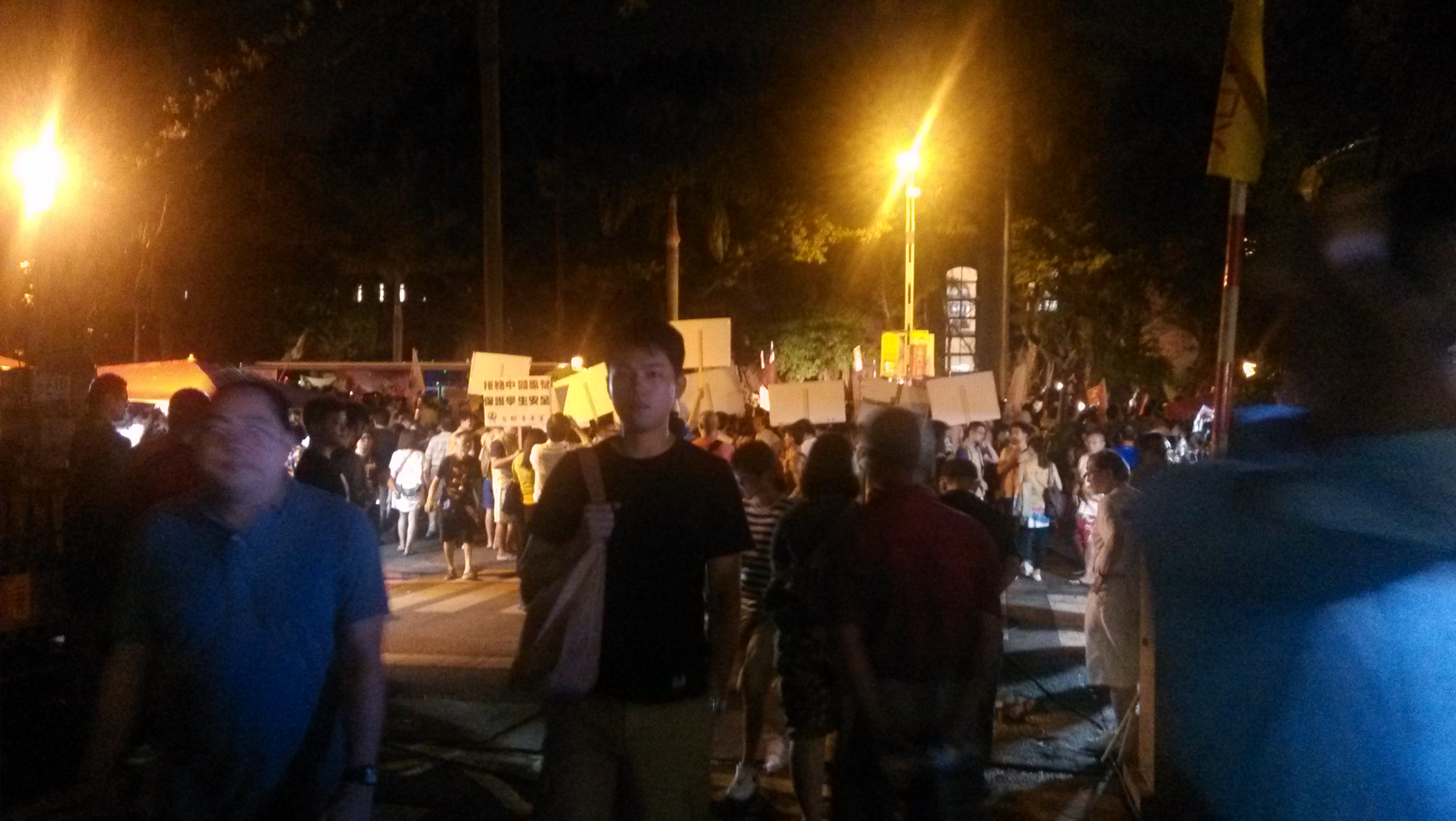 Gathered demonstrators amassed outside the site of the Ministry of Education during the White Wolf’s visit to the encampment site on August 5th. Photo credit: Brian Hioe
Gathered demonstrators amassed outside the site of the Ministry of Education during the White Wolf’s visit to the encampment site on August 5th. Photo credit: Brian Hioe
But if the White Wolf’s visit had temporarily sidelined the question of whether to withdraw or not, with the approach of Typhoon Soudelor slated for the next night, students would declare withdrawal the following day, August 6th. Apart from a surprise visit of Ko Wen-Je to the Ministry of Education site in early evening, apparently in order to get the last word in edgewise, a memorial ceremony for Lin Kuanhua was held from 6:30 to 8:00. This included musical performances and speeches by teachers, as well as the reading of a letter by Lin’s mother and an essay by Lin himself. Many of the student organizers who had known Lin were visibly in tears during this memorial ceremony.
Student organizers announced that they were withdrawing at 8:00 PM, by which time intermittent bursts of rain had already started. Students emphasized that they had not achieved their complete agenda with regard to the repeal of planned textbook changes, but textbooks had been sent back to the Ministry of Education for review and individual high schools would be permitted which textbooks to use. If that meant now that there were two versions of textbooks in circulation, a Sinocentric one and a Taiwan-centric one, students would then have to take the struggle back to their high schools. But it came as no surprise to those who had noticed that there were no preparations on-site to weather the typhoon that students would be withdrawing that night, hence early mistaken reports that a withdrawal had already been announced earlier in the afternoon.
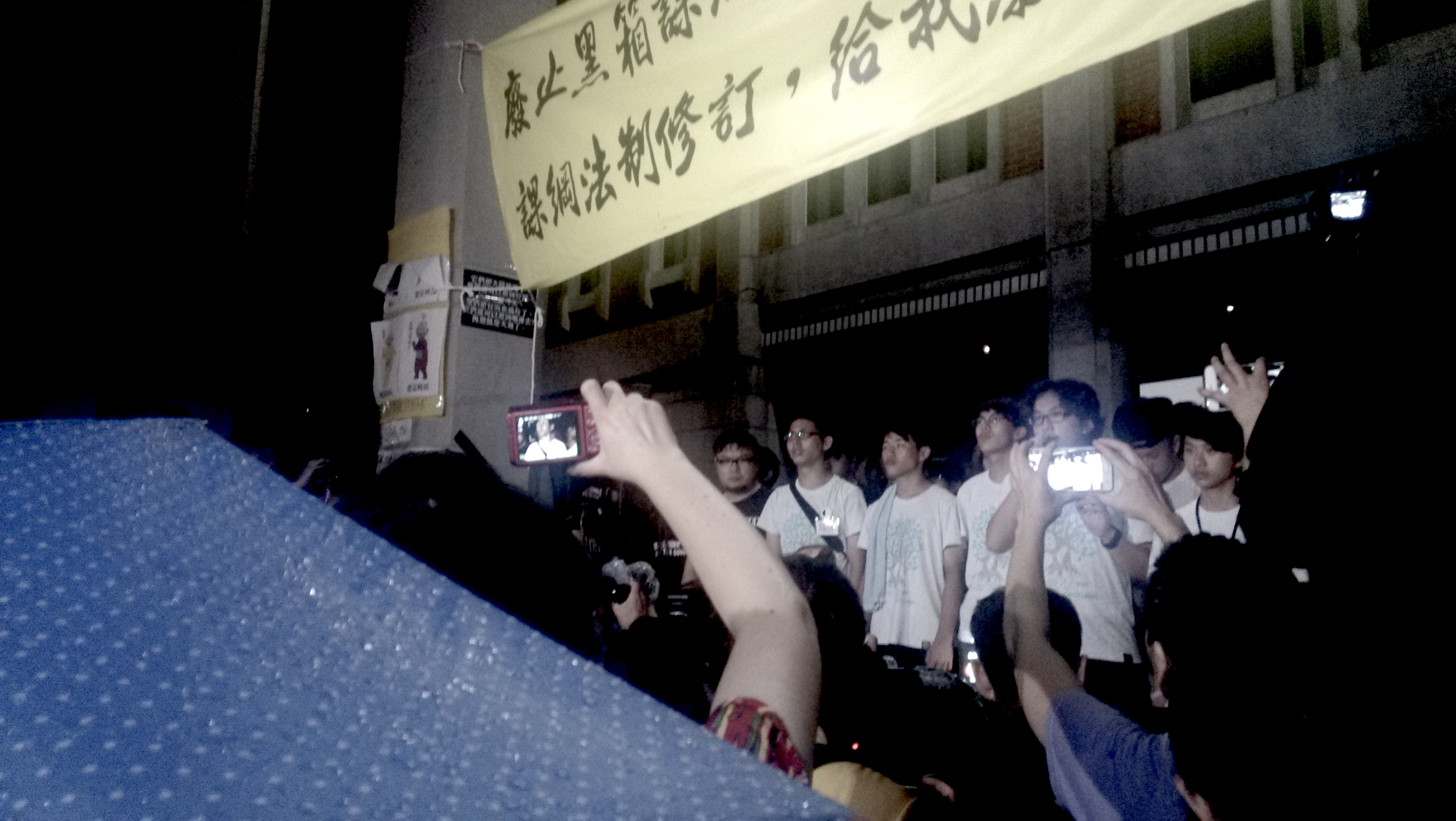 Students declaring an end to the occupation on the night of August 6th, with the approach of Typhoon Soudelor. Photo credit: Brian Hioe
Students declaring an end to the occupation on the night of August 6th, with the approach of Typhoon Soudelor. Photo credit: Brian Hioe
In the end, students bowed, thanked their supporters, and apologized for the shortcomings of the movement. Students then began the work of taking apart the occupation encampment in which they had been living for the last week. Police moved in shortly thereafter, reinforcing the military-grade enforcements of the Ministry of Education and surrounding buildings even further in order to prevent any further occupation attempts.
Resistance Will Continue From Taiwan’s Young
IN RETROSPECT, the issue of textbook revisions is common one found throughout the world, but the series of protests Taiwan has seen over it have been quite exceptional. Whether in Japan, Germany, the US, or elsewhere, textbook revisions usually take place at the hands of conservative political forces which wish to downplay the history of crimes committed by the nation in favor of their sanitized, nationalistic view of history. This is certainly the case in Taiwan, where planned textbook changes aim to downplay the crimes committed by the KMT government in the past.
As shared with Hong Kong, the element which is unusual in the Taiwanese case is where the attempt is made to depict Taiwan as China, but attempts to instill “patriotic education” in Hong Kong’s youth takes place directly at the hands of the Chinese Communist Party, which seeks to inculcate Hong Kong’s next generation with a sense of patriotism to China. In Taiwan, attempts to instill a Sinocentric curriculum take place at the hands of the KMT, in order to maintain its claim to be the sole legitimate government of Taiwan.
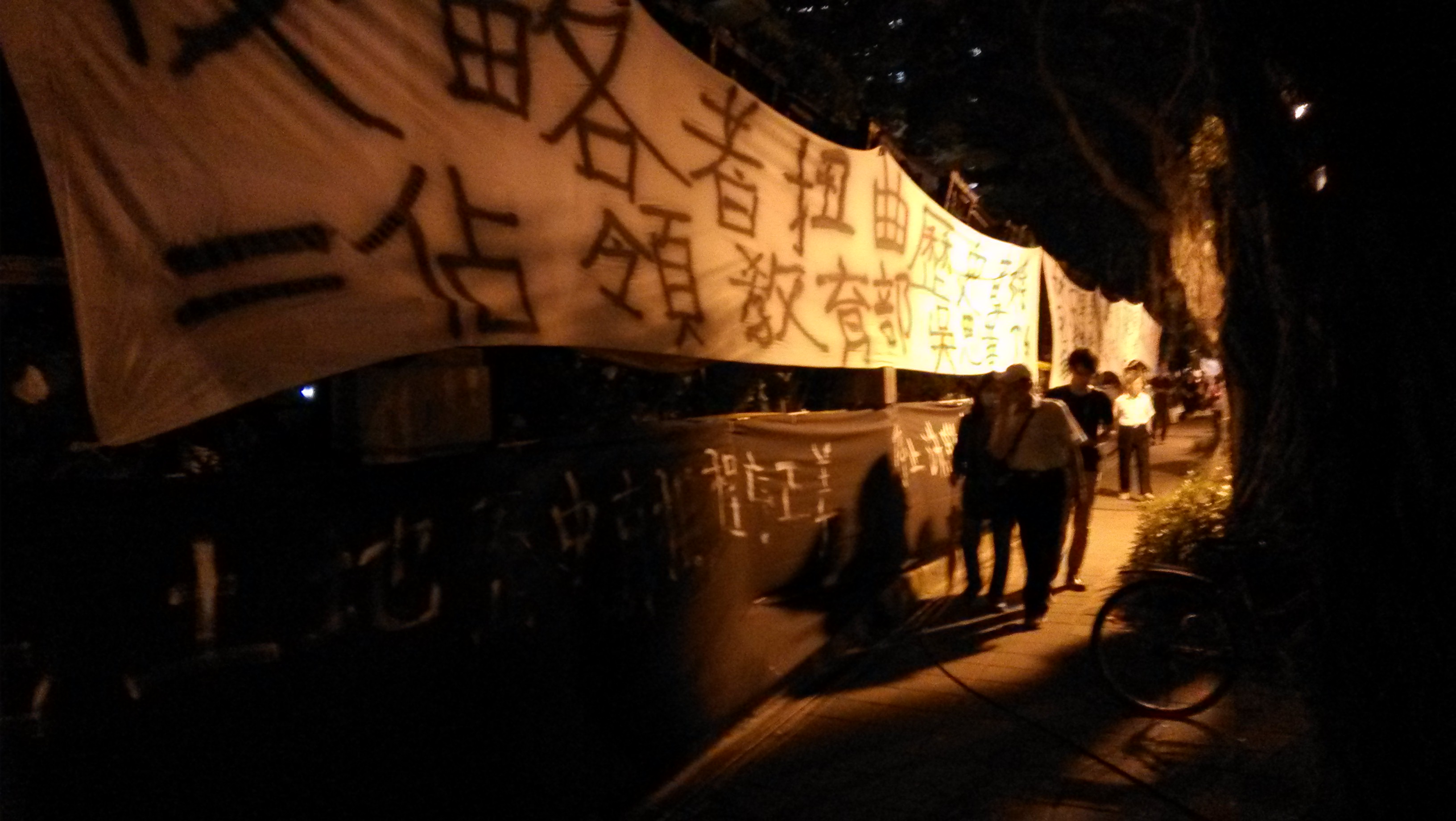 Photo credit: Brian Hioe
Photo credit: Brian Hioe
However, what is exceptional, and seemingly only shared with Hong Kong, is when high school students themselves—and not their parents—rise up in protest over what is taught to them in schoolbooks. And in the Taiwanese case, we saw the extraordinary case of high schoolers leading and maintain an occupation for the course of a week—where high schoolers and secondary school students whose actions sparked off Hong Kong’s Umbrella Movement, but they were one among many forces within the movement itself.
If the protests have been only understood as a anti-China issue to date when reported upon by international media, that is only because of international reportage which understands anything which happens in Taiwan only in context of its larger neighbor. If students themselves did not run a perfect movement or ran a smaller scale movement than last year’s Sunflower Movement, apart from that this is also the product of post-Sunflower exhaustion which lasts to the present, it may be that the movement lasted just long enough in lasting for a week. Arguably, with the Sunflower Movement, the climax of the movement was a little less than two weeks after the occupation began on March 18th, during the large-scale protest of 500,000 which took place on March 30th. After that, there was another protracted week and a half in which the movement was in a messy process of wrapping up.
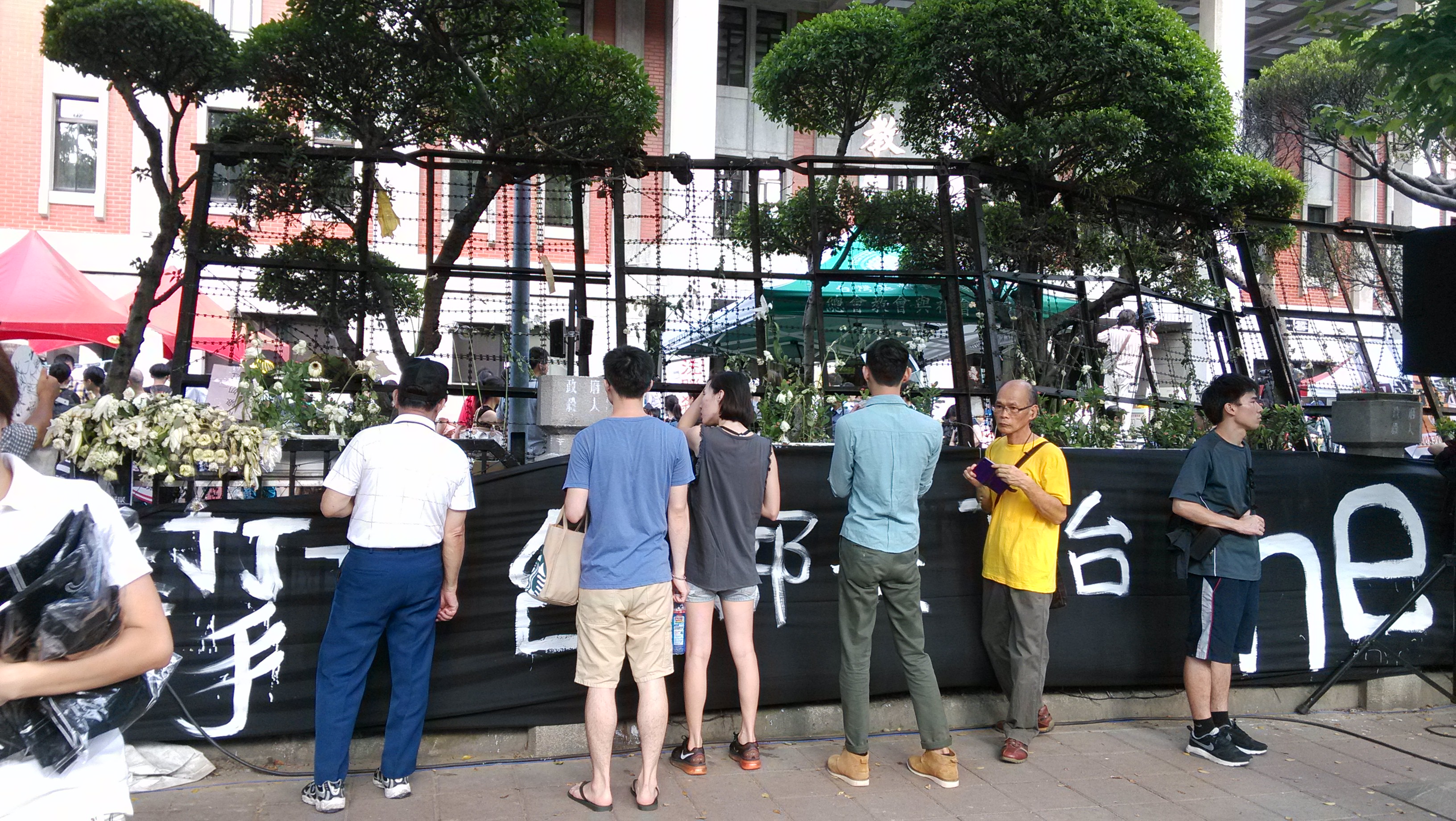 Photo credit: Brian Hioe
Photo credit: Brian Hioe
As with the end of the Sunflower Movement, probably a certain amount of exhaustion and disorganization will set in, and some splits will occur—as is the pattern with the end of any movement or occupation. But we definitely know this: resistance isn’t dead yet in Taiwan. KMT politicians should forever be on guard where Taiwan’s youth are concerned. They are watching.

